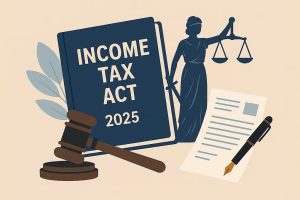Table of Contents
Toggle1. Introduction to Chapter VI-A Deductions
When it comes to tax planning in India, Chapter VI-A of the Income Tax Act plays a central role. This section provides taxpayers with an array of deductions that reduce their taxable income, thereby lowering their overall tax liability. These deductions cover a wide spectrum of expenses and investments, ranging from life insurance premiums and provident fund contributions to health insurance, donations, and education loans.
Chapter VI-A is not just about saving money—it is about encouraging responsible financial habits. The government uses this chapter to nudge taxpayers toward long-term investments, social contributions, and financial security measures like retirement planning and insurance coverage. That is why even in the era of the simplified new tax regime, the old tax regime with Chapter VI-A deductions continues to attract many taxpayers.
The old regime allows individuals to actively manage their taxable income with careful tax planning. Unlike the new regime, which offers lower tax rates but very limited deductions, the old regime rewards those who invest in their financial future and contribute to the nation’s development. For example, an individual investing in Public Provident Fund (PPF), paying premiums for health insurance, and donating to charitable organisations can significantly reduce taxable income under Chapter VI-A.
Understanding these deductions becomes even more important after Budget 2025, which introduced minor but impact changes to certain sections. While the government continues to push the new regime as the default option, taxpayers who maximise Chapter VI-A deductions often find the old regime more rewarding.
In this guide, we will break down every important section under Chapter VI-A, analyse the Budget 2025 updates, and provide examples to help you claim the maximum tax benefit.
2. Overview of the Old Tax Regime in Budget 2025
The Old Tax Regime continues to remain a popular choice despite the government’s push for the new regime. Why? Because the old system offers flexibility, planning opportunities, and a wide range of deductions under Chapter VI-A. Taxpayers who actively invest in tax-saving instruments find that their effective tax liability becomes lower under the old regime compared to the new one.
Budget 2025 introduced a few important updates, but the core structure of Chapter VI-A deductions remains intact. While no drastic changes were made to Section 80C—the backbone of deductions—there were some enhancements in healthcare-related deductions and clarity around home loan-related deductions.
Here are some key highlights of how Budget 2025 impacts the old tax regime:
- Health Insurance (Section 80D): The deduction limit for preventive health check-ups was slightly increased, reflecting the government’s focus on healthcare awareness.
- Education Loans (Section 80E): No new cap was introduced, keeping it highly favourable for students.
- Senior Citizen Benefits (80TTB): Adjustments were made to provide additional relief in the interest income deduction.
- Simplification in Documentation: Budget 2025 announced measures to ease compliance by simplifying proof submission requirements for common deductions.
The Old Tax Regime is still ideal for those who:
- Have significant investments in tax-saving schemes (PPF, ELSS, NSC, etc.).
- Pay premiums for health and life insurance.
- Have ongoing education loans or home loans.
- Make regular donations to charitable organisations.
The choice between the old and new regimes is not just about tax rates but about lifestyle and financial commitments. For individuals who already engage in tax-saving investments, the old regime continues to provide higher net savings.
3. Section 80C: The Most Popular Deduction
Section 80C is the most widely used tax-saving provision under Chapter VI-A. Almost every taxpayer in India has, at some point, claimed deductions under this section. The maximum limit allowed under Section 80C remains ₹1.5 lakh per year, and Budget 2025 did not increase this cap, despite demands from taxpayers and financial experts.
Under Section 80C, taxpayers can claim deductions on various investments and expenses. The eligible instruments include:
- Life Insurance Premiums
- Public Provident Fund (PPF)
- Employee Provident Fund (EPF)
- Equity Linked Saving Schemes (ELSS)
- National Savings Certificate (NSC)
- Sukanya Samriddhi Yojana (SSY)
- Tuition Fees for Children
- 5-year Fixed Deposit in Scheduled Banks
- Repayment of Principal on Home Loan
For example, if you invest ₹1,50,000 in PPF and ELSS combined, you can reduce your taxable income by that amount. Assuming you fall into the 30% tax bracket, this means direct savings of ₹45,000 in taxes.
Budget 2025 did not alter the Section 80C ceiling, but experts continue to argue that the cap should be raised to ₹2.5 lakh to match inflation and encourage more savings. Still, Section 80C remains the most effective starting point for tax planning.
Taxpayers often combine Section 80C with other deductions like 80D and 80E to maximise overall tax savings. However, it’s important to avoid overloading investments purely for tax purposes. Choose instruments that align with your long-term financial goals—whether it is wealth creation through ELSS or guaranteed returns through PPF.
4. Section 80CCC and 80CCD: Retirement Savings Deductions
Retirement planning is a crucial aspect of financial stability, and the Income Tax Act supports this through Sections 80CCC and 80CCD. These sections encourage taxpayers to secure their retirement by investing in pension funds and the National Pension System (NPS).
- Section 80CCC:
Allows deductions for contributions to certain pension funds. However, the limit under this section is clubbed with Section 80C, meaning the overall maximum deduction remains ₹1.5 lakh. - Section 80CCD(1):
This covers contributions made by an individual to the National Pension System (NPS). The maximum allowed is 10% of salary (for salaried employees) or 20% of gross total income (for self-employed individuals), subject to the combined cap under 80C and 80CCD(1). - Section 80CCD(1B):
Introduced to provide additional tax savings, this allows an extra deduction of ₹50,000 exclusively for NPS contributions. This is over and above the ₹1.5 lakh limit under Section 80C. - Section 80CCD(2):
Covers employer contributions to NPS, which can be claimed as a deduction without affecting the 80C/80CCD(1B) limits. The maximum is 10% of salary (14% for central government employees).
For instance, a taxpayer investing ₹1.5 lakh in ELSS under 80C and ₹50,000 in NPS under 80CCD(1B) gets a total deduction of ₹2 lakh. If the employer also contributes 10% of salary to NPS, the deduction could be much higher.
Budget 2025 made slight enhancements by clarifying the treatment of employer contributions for non-central government employees, aligning it with fairness across sectors.
These retirement deductions ensure that taxpayers not only save on taxes but also build a robust financial cushion for their later years. It’s like securing your future self a guaranteed income stream while enjoying tax benefits today.
5. Section 80D: Health Insurance Premium Deductions
Healthcare costs are rising every year, and medical emergencies can drain finances quickly. To encourage people to invest in health insurance, Section 80D allows deductions on premiums paid. This deduction is available for self, spouse, children, and parents.
Here’s a breakdown of deduction limits as per Budget 2025:
- For self, spouse, and children: Up to ₹25,000.
- For parents (if below 60 years): Additional ₹25,000.
- For senior citizen parents (above 60 years): Up to ₹50,000.
- For self (if a senior citizen): Deduction limit also increases to ₹50,000.
- Preventive health check-ups: Allowed up to ₹5,000 within the overall limit.
So, a family with senior citizen parents can claim up to ₹1 lakh under Section 80D. For example, if you pay ₹30,000 for your family’s insurance and ₹50,000 for your parents’ insurance, you can claim ₹80,000 as a deduction.
Budget 2025 slightly enhanced the preventive health check-up component, recognising the importance of early detection and regular health monitoring. This is a positive move as it encourages people to focus on preventive healthcare rather than only relying on treatment after an illness.
When combined with deductions under Sections 80C and 80CCD, Section 80D provides comprehensive financial protection while reducing taxable income. Health insurance is no longer just a safety net; it has become a powerful tax-saving tool as well.





